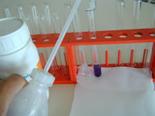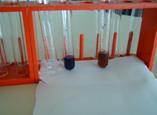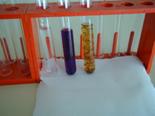Direct Redox Reactions
The transfer of electrons can take place in two ways: spontaneous or forced (non spontaneous)
If particles that are eager to donate, react, have contact with other particles that will capture, very probably the redox reaction will occur spontaneous.
Of course this phenomena has much to do with strong and weak substances.
Another way to divide redox reactions (also to do with electron transfer): direct or indirect redox reactions
In this chapter we will talk about direct redox reactions and in the next chapter about indirect redox reactions.
Equations of the redox reactions
Direct redox reactions occur at the moment of direct contact between the involved particles.
Direct redox reactions can only occur spontaneously; there are no forced direct redox reactions.
You can join weak redox substances, but spontaneously nothing will happen.
If, for example, Oxygen molecules and petrol molecules meet each other (both in gas form = free), the result of this meeting can be a spontaneous redox reaction.
In that case the electron transport from the petrol moleucules to the Oxygen molecules will cause a big difference of substances. New substances are formed, products.
Bondings are broken; new bonds are made, as long as product are being formed (water and carbondioxyde).
The pictures below show a reaction between sulfite and permanganate.



two solids, sodium sulfite and potassium permanganate, are dissolved in water
(one tube with colourless solution and one tube with a purple, transparant solution)
Than we join of both solutions about 1 ml in a third test tube.
A new product is formed, brown and insoluble in water (a brown precipitate is made)
(in the right test tubes some extra water is added to have a better look at colour and precipitate)
Secundary reactions
Mind that many reactions are not finished immediately when the products are formed.
It is very well possible that secondary reactions occur, where products (for example the new oxydator and reductor) are involved.
att.:
- Chlorine is a stronger oxydator than Bromine
- Zn is a stronger reductor than Fe
- Copper(II)- and SilverI)-ions are weak oxydators
- Nitrate and sulfate react only if the oxydator is in acid environment
- Permanganate is in acid environment a stronger oxydator than without acid
- The ion Fe2+ can be both: oxydator and reductor
red 1 + ox 2  ox 1 + red 2
ox 1 + red 2
If the reactants (red1 and ox2)are strong (stronger than the products ox1 and red2), than a spontaneous redox reaction will occur, or: the equilibrium goes far to the right, in favor of the products.
Of red1 and ox2 hardly remains a bit; often we do not even use the equilibrium arrows.


